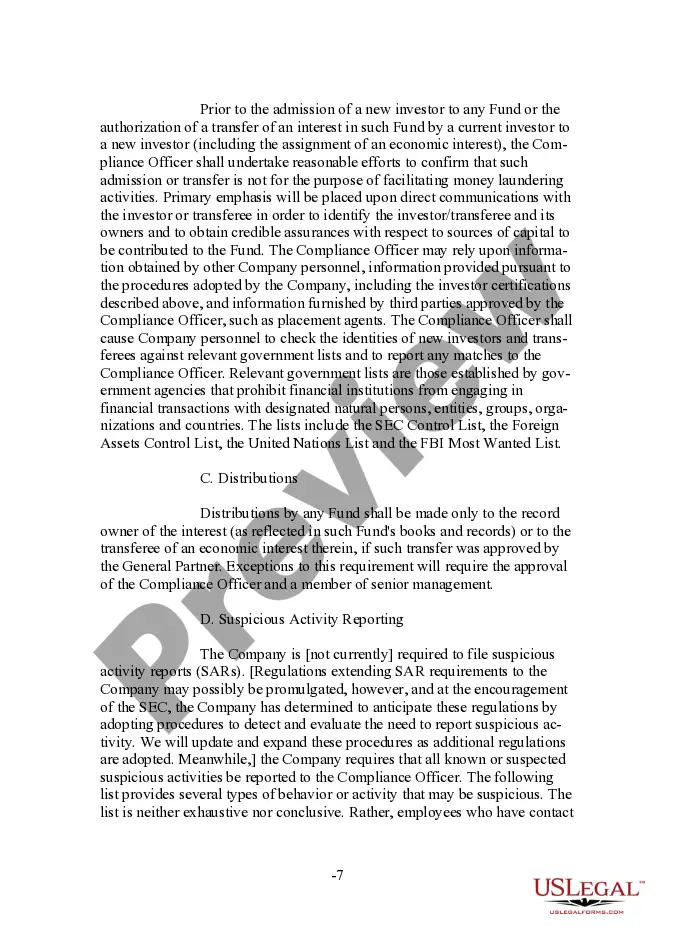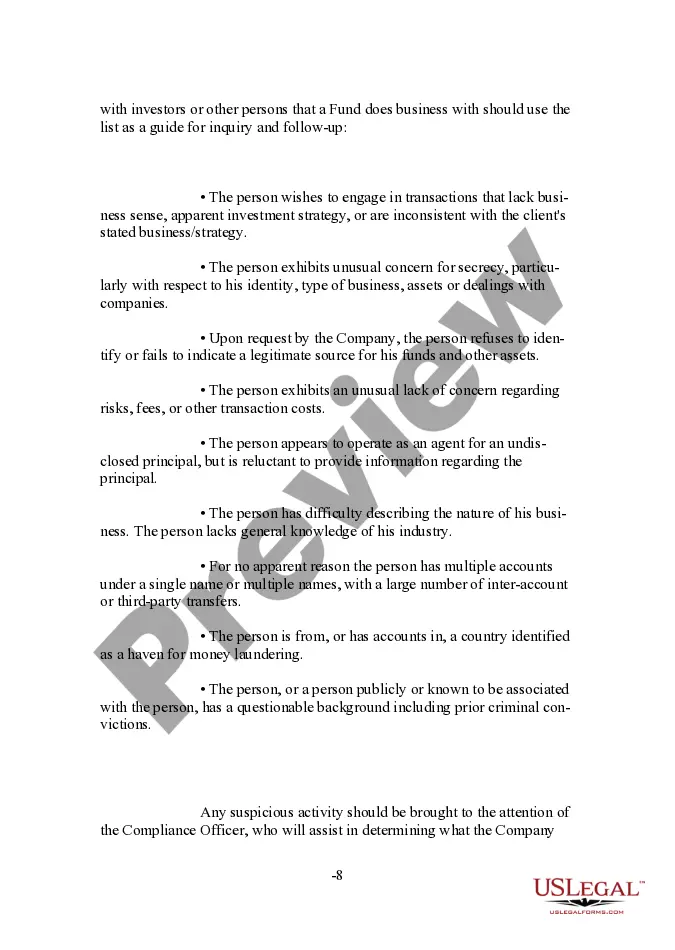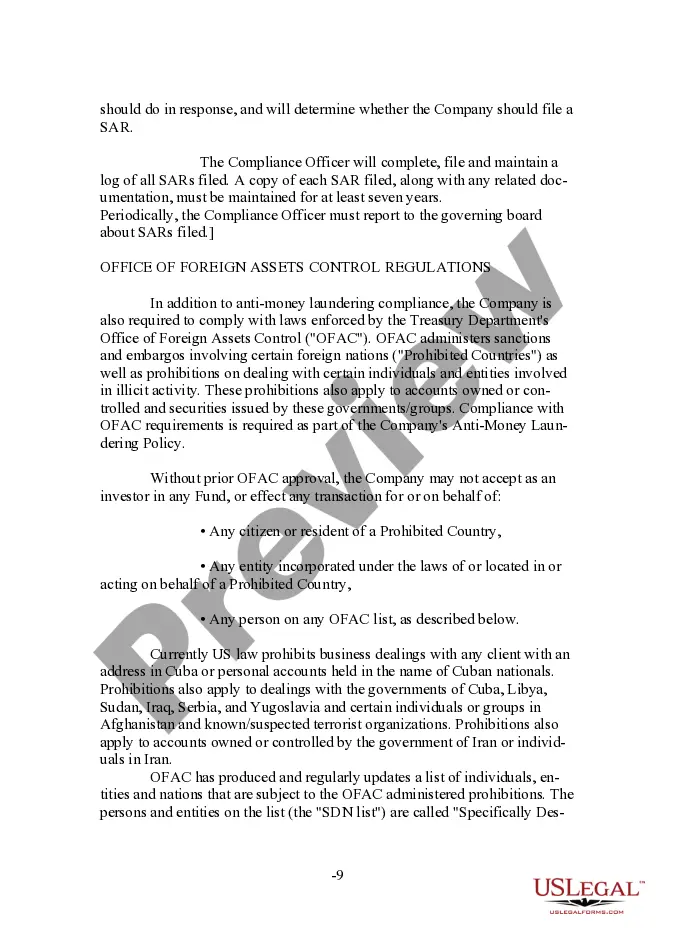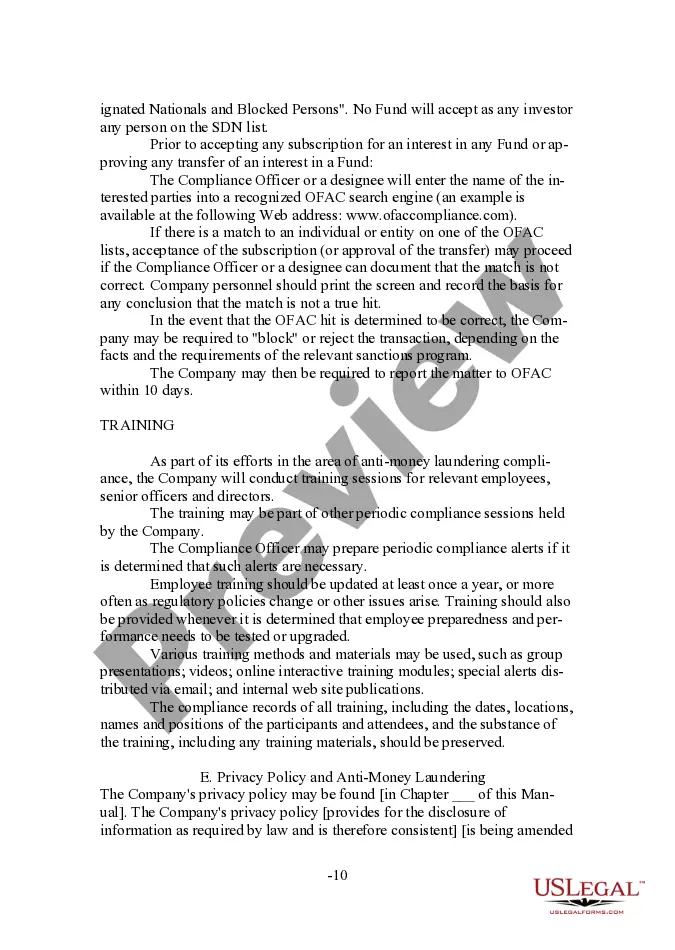Santa Clara California Form of Anti-Money Laundering Policy is a comprehensive and robust strategy developed by the local authorities in Santa Clara, California to prevent, detect, and combat money laundering activities within the city. This policy is designed to align with national and international regulations, such as the Bank Secrecy Act (BSA) and the Financial Action Task Force (FATF) guidelines, to ensure the highest level of compliance and effectiveness. The Santa Clara California Form of Anti-Money Laundering Policy encompasses a wide range of measures and procedures aimed at identifying and mitigating the risks associated with money laundering and terrorist financing. It involves collaboration among government agencies, financial institutions, businesses, and individuals to create a strong network and ensure maximum transparency in financial transactions. One of the key components of the Santa Clara California Form of Anti-Money Laundering Policy is the implementation of stringent customer due diligence procedures. Financial institutions and businesses are required to conduct thorough background checks on their customers, including verifying their identities, assessing their risk levels, and monitoring their transactions for any suspicious activities. This helps to prevent the misuse of the financial system for illicit purposes. Another important aspect of the policy is the reporting of suspicious transactions. Financial institutions and businesses are mandated to report any unusual or suspicious transactions that may indicate potential money laundering or terrorist financing activities. This information is then shared with appropriate law enforcement agencies and regulatory bodies for further investigation. The Santa Clara California Form of Anti-Money Laundering Policy also emphasizes the necessity of ongoing training and awareness programs for employees of financial institutions and businesses. These programs aim to educate staff about the latest trends and techniques used by money launderers and equip them with the necessary skills to identify and report suspicious activities effectively. Furthermore, the policy includes frequent and comprehensive audits conducted by independent third parties to assess the adherence to the Anti-Money Laundering measures and identify any areas that require improvement. Different types of Santa Clara California Form of Anti-Money Laundering Policy may include: 1. Banking AML Policy: Specifically designed for banks and financial institutions operating in Santa Clara, California, this policy provides guidance on how to comply with local and international AML regulations while maintaining the integrity of their financial services. 2. Real Estate AML Policy: Tailored for real estate agencies and professionals, this policy focuses on preventing money laundering in property transactions, which can often be used as a tool to legitimize illicit funds. 3. Non-Profit Organization AML Policy: Non-profit organizations are also susceptible to money laundering risks. This policy provides guidelines and measures for non-profit organizations to prevent their involvement in money laundering and terrorist financing activities. 4. Digital Currency AML Policy: With the rise of cryptocurrencies and digital assets, this policy addresses the unique challenges associated with virtual currencies and provides guidelines for businesses involved in these sectors. In conclusion, the Santa Clara California Form of Anti-Money Laundering Policy serves as a comprehensive framework to combat money laundering and terrorist financing activities in the city. By implementing strict regulations, promoting transparency, and fostering cooperation among various stakeholders, Santa Clara aims to ensure the integrity of its financial system and protect its community from the detrimental effects of money laundering.
Santa Clara California Form of Anti-Money Laundering Policy
Description
How to fill out Santa Clara California Form Of Anti-Money Laundering Policy?
Laws and regulations in every sphere vary throughout the country. If you're not an attorney, it's easy to get lost in countless norms when it comes to drafting legal documents. To avoid pricey legal assistance when preparing the Santa Clara Form of Anti-Money Laundering Policy, you need a verified template legitimate for your region. That's when using the US Legal Forms platform is so beneficial.
US Legal Forms is a trusted by millions online library of more than 85,000 state-specific legal templates. It's an excellent solution for professionals and individuals searching for do-it-yourself templates for different life and business occasions. All the forms can be used multiple times: once you purchase a sample, it remains accessible in your profile for subsequent use. Therefore, if you have an account with a valid subscription, you can simply log in and re-download the Santa Clara Form of Anti-Money Laundering Policy from the My Forms tab.
For new users, it's necessary to make a couple of more steps to obtain the Santa Clara Form of Anti-Money Laundering Policy:
- Take a look at the page content to make sure you found the right sample.
- Use the Preview option or read the form description if available.
- Look for another doc if there are inconsistencies with any of your criteria.
- Click on the Buy Now button to get the template once you find the right one.
- Choose one of the subscription plans and log in or sign up for an account.
- Decide how you prefer to pay for your subscription (with a credit card or PayPal).
- Pick the format you want to save the document in and click Download.
- Fill out and sign the template on paper after printing it or do it all electronically.
That's the easiest and most economical way to get up-to-date templates for any legal purposes. Find them all in clicks and keep your paperwork in order with the US Legal Forms!
Form popularity
FAQ
There are three major steps in money laundering (placement, layering, and integration), and various controls are put in place to monitor suspicious activity that could be involved in money laundering.
What are the 5 Pillars of AML Compliance that One Should Consider? Implementation of Effective Internal Controls.Designation of a Compliance (AML) Officer.Appropriate Periodic TrainingForEmployees.Independent Testing of the Program.Customer Due Diligence.
What is an AML Compliance Program required to have? The Bank Secrecy Act, among other things, requires financial institutions, including broker-dealers, to develop and implement AML compliance programs. Members are also governed by the anti-money laundering rule in FINRA Rule 3310.
Currently, institutional AML programs are based on the five pillars: internal policies, procedures and controls; designation of an AML officer; employee training; independent testing; and customer due diligence (CDD).
Combating of Financing of Terrorism (CFT) The objective of KYC/AML/CFT guidelines is to prevent banks from being used, intentionally or unintentionally, by criminal elements for money laundering or terrorist financing activities.
How To Create an AML Policy Firm Policy. AML Compliance Personnel Designations. Sharing AML Information with Law Enforcement. Sharing AML Information with Other Financial Institutions. Procedure for Checking Sanctions Lists. Know Your Customer (KYC) Compliance. Customer Due Diligence.
Anti-money laundering policy is created by financial companies that aim to prevent revenues from illegal activities. It is mandatory to comply with these rules within the company. Regulatory authorities also control it. AML policy in businesses is regulated according to the country's recommendations and FATF.
The key 5 pillars of an AML Program are internal controls, a designated BSA officer, ongoing training, independent testing, and customer due diligence (CDD) the newest pillar. Staying on top of BSA compliance and suspicious activity can feel overwhelming.
The written BSA/AML compliance program must include the following four pillars: Internal controls; The designation of a BSA/AML officer; A BSA/AML training program; and. Independent testing to test programs.
WASHINGTONThe Financial Crimes Enforcement Network (FinCEN) today announced the renewal and expansion of its Geographic Targeting Orders (GTOs) that require U.S. title insurance companies to identify the natural persons behind shell companies used in all-cash purchases of residential real estate.
Interesting Questions
More info
You must find your way to the bank. If you don't pay, the bank may get your money. What if the bank repossesses its own cash storage safe when it is damaged in a fire? What if it doesn't want to let you take a car to a car wash? You know the answer. This article is a practical guide to these financial uncertainties and issues that can affect you. Article 5: Federal and State Financial Aid. The Federal Student Aid (FAFSA) serves as the official national database of financial aid and the most comprehensive federal document of student eligibility. In addition to the official federal financial aid formula, the information collected from students through the FAFSA is used by colleges and universities in evaluating their financial readiness to receive the grants, work-study financial aid, or Title IV non-need-based financial assistance.
Disclaimer
The materials in this section are taken from public sources. We disclaim all representations or any warranties, express or implied, as to the accuracy, authenticity, reliability, accessibility, adequacy, or completeness of any data in this paragraph. Nevertheless, we make every effort to cite public sources deemed reliable and trustworthy.





















